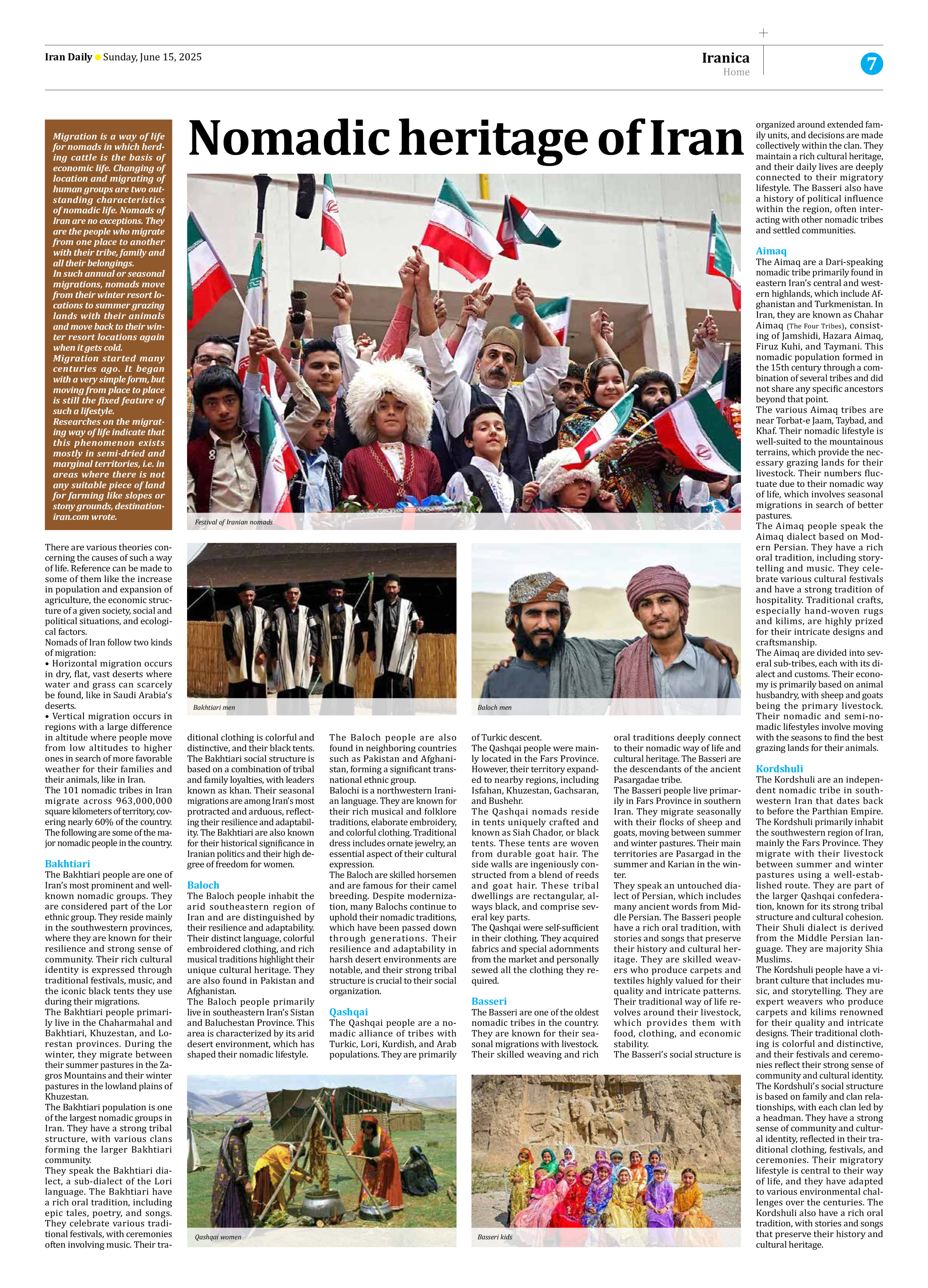
Nomadic heritage of Iran
Migration is a way of life for nomads in which herding cattle is the basis of economic life. Changing of location and migrating of human groups are two outstanding characteristics of nomadic life. Nomads of Iran are no exceptions. They are the people who migrate from one place to another with their tribe, family and all their belongings. In such annual or seasonal migrations, nomads move from their winter resort locations to summer grazing lands with their animals and move back to their winter resort locations again when it gets cold. Migration started many centuries ago. It began with a very simple form, but moving from place to place is still the fixed feature of such a lifestyle. Researches on the migrating way of life indicate that this phenomenon exists mostly in semi-dried and marginal territories, i.e. in areas where there is not any suitable piece of land for farming like slopes or stony grounds, destinationiran.com wrote.
There are various theories concerning the causes of such a way of life. Reference can be made to some of them like the increase in population and expansion of agriculture, the economic structure of a given society, social and political situations, and ecological factors.
Nomads of Iran follow two kinds of migration:
• Horizontal migration occurs in dry, flat, vast deserts where water and grass can scarcely be found, like in Saudi Arabia‘s deserts.
• Vertical migration occurs in regions with a large difference in altitude where people move from low altitudes to higher ones in search of more favorable weather for their families and their animals, like in Iran.
The 101 nomadic tribes in Iran migrate across 963,000,000 square kilometers of territory, covering nearly 60% of the country. The following are some of the major nomadic people in the country.
Bakhtiari
The Bakhtiari people are one of Iran’s most prominent and well-known nomadic groups. They are considered part of the Lor ethnic group. They reside mainly in the southwestern provinces, where they are known for their resilience and strong sense of community. Their rich cultural identity is expressed through traditional festivals, music, and the iconic black tents they use during their migrations.
The Bakhtiari people primarily live in the Chaharmahal and Bakhtiari, Khuzestan, and Lorestan provinces. During the winter, they migrate between their summer pastures in the Zagros Mountains and their winter pastures in the lowland plains of Khuzestan.
The Bakhtiari population is one of the largest nomadic groups in Iran. They have a strong tribal structure, with various clans forming the larger Bakhtiari community.
They speak the Bakhtiari dialect, a sub-dialect of the Lori language. The Bakhtiari have a rich oral tradition, including epic tales, poetry, and songs. They celebrate various traditional festivals, with ceremonies often involving music. Their traditional clothing is colorful and distinctive, and their black tents.
The Bakhtiari social structure is based on a combination of tribal and family loyalties, with leaders known as khan. Their seasonal migrations are among Iran’s most protracted and arduous, reflecting their resilience and adaptability. The Bakhtiari are also known for their historical significance in Iranian politics and their high degree of freedom for women.
Baloch
The Baloch people inhabit the arid southeastern region of Iran and are distinguished by their resilience and adaptability. Their distinct language, colorful embroidered clothing, and rich musical traditions highlight their unique cultural heritage. They are also found in Pakistan and Afghanistan.
The Baloch people primarily live in southeastern Iran’s Sistan and Baluchestan Province. This area is characterized by its arid desert environment, which has shaped their nomadic lifestyle.
The Baloch people are also found in neighboring countries such as Pakistan and Afghanistan, forming a significant transnational ethnic group.
Balochi is a northwestern Iranian language. They are known for their rich musical and folklore traditions, elaborate embroidery, and colorful clothing. Traditional dress includes ornate jewelry, an essential aspect of their cultural expression.
The Baloch are skilled horsemen and are famous for their camel breeding. Despite modernization, many Balochs continue to uphold their nomadic traditions, which have been passed down through generations. Their resilience and adaptability in harsh desert environments are notable, and their strong tribal structure is crucial to their social organization.
Qashqai
The Qashqai people are a nomadic alliance of tribes with Turkic, Lori, Kurdish, and Arab populations. They are primarily of Turkic descent.
The Qashqai people were mainly located in the Fars Province. However, their territory expanded to nearby regions, including Isfahan, Khuzestan, Gachsaran, and Bushehr.
The Qashqai nomads reside in tents uniquely crafted and known as Siah Chador, or black tents. These tents are woven from durable goat hair. The side walls are ingeniously constructed from a blend of reeds and goat hair. These tribal dwellings are rectangular, always black, and comprise several key parts.
The Qashqai were self-sufficient in their clothing. They acquired fabrics and special adornments from the market and personally sewed all the clothing they required.
Basseri
The Basseri are one of the oldest nomadic tribes in the country. They are known for their seasonal migrations with livestock. Their skilled weaving and rich oral traditions deeply connect to their nomadic way of life and cultural heritage. The Basseri are the descendants of the ancient Pasargadae tribe.
The Basseri people live primarily in Fars Province in southern Iran. They migrate seasonally with their flocks of sheep and goats, moving between summer and winter pastures. Their main territories are Pasargad in the summer and Karian in the winter.
They speak an untouched dialect of Persian, which includes many ancient words from Middle Persian. The Basseri people have a rich oral tradition, with stories and songs that preserve their history and cultural heritage. They are skilled weavers who produce carpets and textiles highly valued for their quality and intricate patterns. Their traditional way of life revolves around their livestock, which provides them with food, clothing, and economic stability.
The Basseri’s social structure is organized around extended family units, and decisions are made collectively within the clan. They maintain a rich cultural heritage, and their daily lives are deeply connected to their migratory lifestyle. The Basseri also have a history of political influence within the region, often interacting with other nomadic tribes and settled communities.
Aimaq
The Aimaq are a Dari-speaking nomadic tribe primarily found in eastern Iran’s central and western highlands, which include Afghanistan and Turkmenistan. In Iran, they are known as Chahar Aimaq (The Four Tribes), consisting of Jamshidi, Hazara Aimaq, Firuz Kuhi, and Taymani. This nomadic population formed in the 15th century through a combination of several tribes and did not share any specific ancestors beyond that point.
The various Aimaq tribes are near Torbat-e Jaam, Taybad, and Khaf. Their nomadic lifestyle is well-suited to the mountainous terrains, which provide the necessary grazing lands for their livestock. Their numbers fluctuate due to their nomadic way of life, which involves seasonal migrations in search of better pastures.
The Aimaq people speak the Aimaq dialect based on Modern Persian. They have a rich oral tradition, including storytelling and music. They celebrate various cultural festivals and have a strong tradition of hospitality. Traditional crafts, especially hand-woven rugs and kilims, are highly prized for their intricate designs and craftsmanship.
The Aimaq are divided into several sub-tribes, each with its dialect and customs. Their economy is primarily based on animal husbandry, with sheep and goats being the primary livestock. Their nomadic and semi-nomadic lifestyles involve moving with the seasons to find the best grazing lands for their animals.
Kordshuli
The Kordshuli are an independent nomadic tribe in southwestern Iran that dates back to before the Parthian Empire. The Kordshuli primarily inhabit the southwestern region of Iran, mainly the Fars Province. They migrate with their livestock between summer and winter pastures using a well-established route. They are part of the larger Qashqai confederation, known for its strong tribal structure and cultural cohesion. Their Shuli dialect is derived from the Middle Persian language. They are majority Shia Muslims.
The Kordshuli people have a vibrant culture that includes music, and storytelling. They are expert weavers who produce carpets and kilims renowned for their quality and intricate designs. Their traditional clothing is colorful and distinctive, and their festivals and ceremonies reflect their strong sense of community and cultural identity.
The Kordshuli’s social structure is based on family and clan relationships, with each clan led by a headman. They have a strong sense of community and cultural identity, reflected in their traditional clothing, festivals, and ceremonies. Their migratory lifestyle is central to their way of life, and they have adapted to various environmental challenges over the centuries. The Kordshuli also have a rich oral tradition, with stories and songs that preserve their history and cultural heritage.







